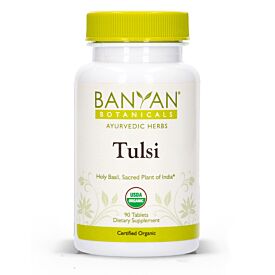Ayurvedic Herbs: Tulsi
/Ayurvedic Herbs
Ayurvedic herbs are one of the many chikitsas or treatments used in Ayurvedic medicine. These herbs are used as part of an herbal protocol recommended by an Ayurvedic professional. Ayurvedic herbs should not be self-administered and Ayurvedic herbs should only be taken under-advisement of an Ayurvedic Professional and approved by your Primary Care Physician. The information on the Ayurvedic herb of Tulsi is only meant to educate you on the ways in which it is traditionally used in Ayurveda and is presented for educational purposes only. It is not intended as a substitute for the diagnosis, treatment, or advice of a qualified, licensed medical professional. The facts presented are offered as information only, not medical advice, and in no way should anyone infer that we are practicing medicine. Seek the advice of a medical professional for proper application of this material to any specific situation. Do not use the information found within this post to self-diagnose any medical conditions or treat any health problems or diseases. The information provided is not intended to prescribe or be taken as medical advice. If you have or suspect that you have a medical condition please contact your health care provider immediately.
“The essence of all beings is Earth. The essence of Earth is Water. The essence of Water is plants. The essence of plants is the human being.
Esam bhutanam prthivi rasha, prthivya apo raso-pam osadhayo rasa, osadhinam puruso rasah.”
Tulsi
Latin Name: Ocimum sanctum-folium
Plant Family: Labiatae
English Name: Holy Basil
Sanskrit Name: Tulsi
Part Used: herb
Botanical Description: a shrub of 0.5 to 0.75 meters high; leaves are 3 centimeters long and have an odor; flowers are inflorenscence and 12 to 14 centimeters long
Taste (Rasa): pungent, bitter
Energetics (Virya): heating
Post-Digestive Effect (Vipaka): pungent
Quality (Guna): light, dry
Dosha: VK- P+
Tissues (Dhatu): plasma (rasa), blood (rakta), nerve/bone marrow (majja), reproductive tissue (shukra [male]/artava [female])
Systems (Srotamsi): circulatory (rakta vaha srotas), digestive (anna vaha srotas), respiratory (prana vaha srotas), nervous (majja vaha srotas), urinary (mutra vaha srotas)
Constituents: essential oil (eogenol, methyl-eugenol, carvacrol, limatrol, carophyllene); sterols (B-sitosterol, stigmasterol); flavonoids; fatty acids
Actions: diaphoretic, febrifuge, nervine, antispasmodic, antibacterial, antiseptic
Ayurvedic Actions: alleviates fevers (jvarahara); diaphoretic (svedala), benefits breathing and alleviates coughing (rsvasakasahara); enkindles the digestive fire (dipana); specific affinity for the heart (hrdaya); alleviates skin disorders (kustha); alleviates dysuria (seed) (mutrakrcchraghna)
Biomedical Actions: expectorant, febrifuge, diaphoretic, antispasmodic, antibacterial, nervine, carminative, aromatic
Indications: lungs, digestion, nerves, heart
Precautions: respiratory infections, high Pitta without other cooling herbs, theoretical evidence that its eugenol content may deplete glutathione from the liver, caution should be used in people using glutathione-depleting medication such as paracetamol
Preparations: infusion, powder, juice, medicated ghee
Tulsi is a spirit cleansing herb like palo santo is for South American indigenous people and sage is for North American indigenous people. Tulsi has an affinity for the brain and clears the mind to allow for more connection with universal wisdom and increased devotion to the divine cosmic consciousness.
References
Frawley D. Yoga & Ayurveda: Self-Healing and Self-Realization. Twin Lakes, Wisconsin: Lotus Press; 1999.
Frawley D, Lad V. The Yoga of Herbs: An Ayurvedic Guide to Herbal Medicine. Twin Lakes, Wisconsin: Lotus Press; 2001.
Gogte VM. Ayurvedic Pharmacology & Therapeutic Uses of Medicinal Plants: Dravyagunavignyam. New Delhi, India: Chaukhambha Publications; 2016.
Pole S. Ayurvedic Medicine: The Principles of Traditional Practice. Philadelphia, PA: Singing Dragon; 2013.






